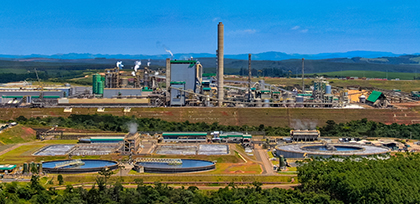Water use
Monitor to manage impacts
One of the key tools for water management at Klabin is monitoring, which enables periodically critical assessments to be conducted across all units and actions to be taken on any deviations that could affect the progress of indicators. In 2022, more than launching new projects, operational adjustments were made with a focus on continuously improving processes to reduce water consumption.
One of the KSDG targets is to reduce specific water consumption by 20% by 2030, based on 2018. Specific consumption is the result of subtracting the amount of effluent treated and returned to the source from the amount of water withdrawn from the source. The indicator that contributes to the target performed well in 2022: 3.63m3 per ton of product, leading to a 17.9% reduction in specific water consumption in the period, compared to the target's base year (2018).
Hydrosolidarity in water management
set of practices that enables proper guidance on the use of land and other natural resources in order to produce environmental goods and services, without affecting the soil and water.
GlossárioFor the application of the methodology, several parameters are considered, especially the size of the forest blocks to be managed and their composition (with regard to gender and age). With this, Klabin seeks the continuity of the forest mosaic, which has been practiced for many years.
Klabin's own forestry operation in Paraná is already utilizing the hydrosolidarity management flow. In 2022, 100% of the operation in Santa Catarina also began to use it. As a result, the Company saw a significant improvement in the indicator, nearing the KSDG goal of having 100% of forestry operations under its own management with hydrosolidarity management by 2030. Klabin is currently working to ensure that, by 2024, its forests located in São Paulo will also operate under this strategy.
Water stress
An area is called water stress when it reaches rates greater than 20% of the proportion between the total water withdrawn annually and the annual renewable supply available. For this control, Klabin monitors all its units through the WRI Aqueduct tool, which allows prioritizing actions in the most vulnerable territories. In 2022, Klabin's units classified as areas of water stress were: Franco da Rocha, Jundiaí-DI, Jundiaí-TP and Suzano, in São Paulo; Goiana (PE), Horizonte (CE) and Rio Verde (GO).
An area is called water stress when it reaches rates higher than 20% of the ratio between the total water withdrawn annually and the annual renewable supply available. For this control, Klabin monitors all its units through the WRI Aqueduct tool, which allows prioritizing actions in the most vulnerable territories.
Taking initiatives to increase territorial water security in all locations where the Company operates is one of the targets of the Klabin 2030 Agenda.
The results of the indicator have been steadily improving year after year (see Indicator Overview below), due to initiatives such as the installation of more efficient Effluent Treatment Plants (Betim, Itajaí, Manaus, Rio Negro, Goiana and São Leopoldo), participation in Watershed Committees and the environmental education actions of the Klabin Caiubi Program, involving the Monte Alegre and Puma units in Paraná; Otacílio Costa, Lages and Correia Pinto in Santa Catarina; Feira de Santana in Bahia, and Angatuba, Jundiaí DI and Jundiai TP in São Paulo. The strategic performance of the Water Management Working Group, a team comprised of representatives from all of Klabin's businesses, has made a significant contribution to the results.
Indicator Overview
Management of effluent disposal
acronym for biochemical oxygen demand. This is a standard test, performed at a constant temperature and during a five-day incubation period, to measure the oxygen consumption in water. It is measured by the difference of the amount of dissolved oxygen (DO) found before and after the incubation period.
Glossárioacronym for the Intergovernmental Panel on Climate Change. Created by the United Nations Environment Program (UN Environment) and the World Meteorological Organization (WMO), it aims to provide policy makers with regular scientific assessments of climate change, its implications and possible future risks, as well as propose adaptation alternatives and damage mitigation policies.
Glossáriosigla de Intergovernmental Panel on Climate Change (Painel Intergovernamental sobre Mudanças Climáticas). Criado pelo Programa das Nações Unidas para o Meio Ambiente (ONU Meio Ambiente) e pela Organização Meteorológica Mundial (OMM), tem como objetivo não só fornecer aos formuladores de políticas avaliações científicas regulares sobre as mudanças climáticas, suas implicações e possíveis riscos futuros como também propor opções de adaptação das políticas e de mitigação de danos.
Glossário
Treated effluents
Treated effluents
Before being released into water bodies, 100% of effluents are treated in Effluent Treatment Plants (ETPs), monitored internally and verified by external auditors to ensure compliance with all legal requirements. In several of the Company’s units, water-related targets impact the Profit Sharing Program (PPR).

The Otacílio Costa Unit (SC) has the highest quality effluent of any Klabin facility, the result of technological upgrade projects.

The Puma II project already has 100% of the effluents treated by the tertiary level of the Puma Unit (PR), observed the standards set by the International Finance Corporation (IFC).











